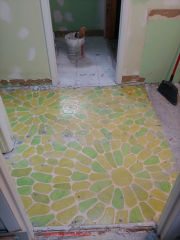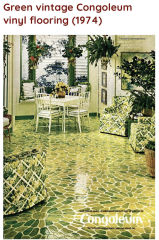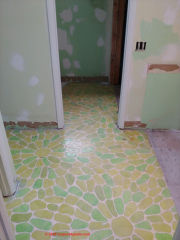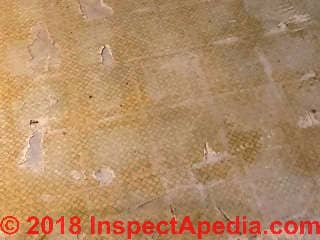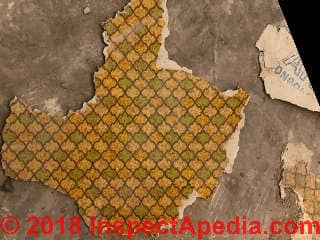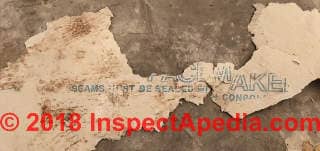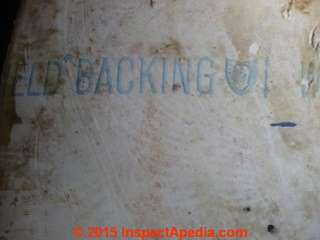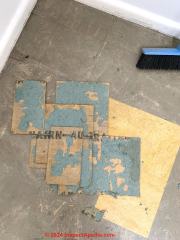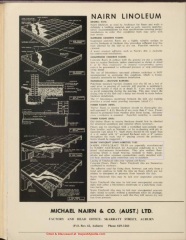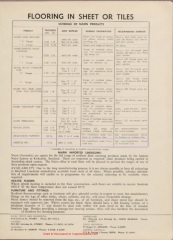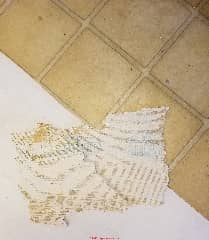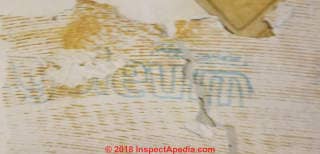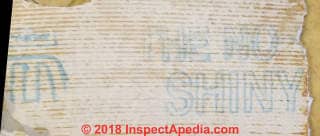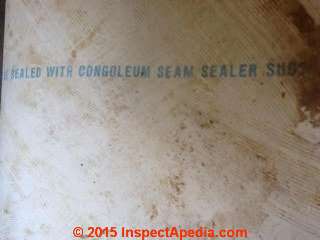 1970s Congoleum Nairn Sheet Flooring & Floor Tile
1970s Congoleum Nairn Sheet Flooring & Floor Tile
Some 1970s Congoleum flooring contained asbestos
- POST a QUESTION or COMMENT about identifying Congoleum or Congoleum Nairn flooring materials & their asbestos content
Congoleum flooring identification:
This article provides a guide to identifying traditional or early Congoleum rugs and other sheet flooring products, Congoleum-Nairn asphalt-asbestos, vinyl asbestos floor tiles, linoleum, and sheet flooring (resilient flooring).
Some of these Congoleum floor covering materials contain asbestos in asbestos fiber or asbestos powder-filler form.
InspectAPedia tolerates no conflicts of interest. We have no relationship with advertisers, products, or services discussed at this website.
- Daniel Friedman, Publisher/Editor/Author - See WHO ARE WE?
Asbestos in Some 1970s Congoleum-Nairn Vinyl-Asbestos Floor Tiles & Congoleum Linoleum Sheet Flooring
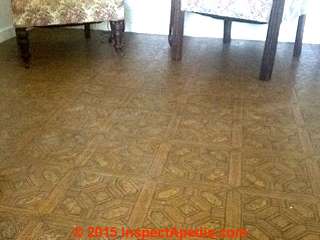 Asbestos was found in at some Congoleum flooring products including: Congoleum-Nairn Flor-Ever Vinyl, Fashionflor Cushioned Vinyl flooring, Gold Seal Vinyl Inlaid flooring, Gold Seal Vinyl Nairon Standard flooring.
Asbestos was found in at some Congoleum flooring products including: Congoleum-Nairn Flor-Ever Vinyl, Fashionflor Cushioned Vinyl flooring, Gold Seal Vinyl Inlaid flooring, Gold Seal Vinyl Nairon Standard flooring.
Asbestos is safe and legal to remain in homes or public buildings as long as the asbestos materials are in good condition and the asbestos can not be released into the air.
SEQUIN PATTERN [image] Congoleum resilient flooring is shown above.
[Click to enlarge any image]
Congoleum Sheet Flooring, 1970's Asbestos Content
Question:
I am doing renovation on a 1978 house. While busting up tile in about 150 sqft it was revealed that there was linoleum sheet flooring underneath.
I could [not] read all the back of it but did see "Pacemaker" and saw it was a Congoleum product. I saw that product on a list of asbestos-related flooring, but the damage was done. Not all the flooring came up but a good amount did with the tile jack.
Any thoughts? - Anonymous by private email 2018/09/09
Reply: 1970's Congoleum sheet flooring may contain asbestos - as well as Congoleum flooring up to 1984.
You're right, Anon, that Congoleum Pacemaker flooring contained asbestos - Congoleum Pacemaker is among the product names listed
at CONGOLEUM FLOOR PRODUCTS CONTAINING ASBESTOS.
However at least one reader reported having tested later Congoleum Pacemaker and finding it contained no asbestos.
"Pacemaker II" from Congoleum contained no Asbestos in it. The trademark for the stamp was issued in 1982.
Details are at CONGOLEUM-NAIRN FLOOR TILES & LINOLEUM FAQs
Typical sources and the mesothelioma websites and lawyers typically assert that Congoleum's sheet flooring products between 1958 and 1968 contained asbestos. Other websites put the end date for asbestos in flooring as 1979. Still other law firms cite 1980 as Congoleum's last year producing asbestos-containing flooring.
Most of those web pages and authors are, by our research and by our own lab reports, mistaken:
Asbestos has been confirmed in Congoleum sheet flooring by lab tests reported by some of our readers for Congoleum flooring installed as recently as the early 1980s. Note that that is a bit past 1980.
Now it's possible that "new old stock" asbestos-backed floor tiles or sheet flooring that were manufactured before 1969 (or those later years I cited) were installed at later dates but that assumption may not be sufficient to rule the asbestos-question in or out.
It is common for both asphalt-impregnated felt-backed flooring products and the light or near-white waxy paper-like backing on sheet flooring from the 1970's and early 1980's to contain asbestos.
See 1980 CONGOLEUM NO-WAX SHEET FLOORING - With Asbestos-Content - for an example.
Therefore I agree that for a 1970's Congoleum floor material that has not been tested to confirm the presence or absence of asbestos, it would be prudent to treat the floor as PACM - Presumed Asbestos Containing Material.
You will want to do the obvious: damp wipe, HEPA vacuum up dust, and don't make more of a dusty mess when removing the remainder.
Below I will give two asbestos floor removal article links that you should review before doing more work on the floor in your home.
If you want to have a sample tested, which you certainly should do if you're facing a large cleanup or removal expense now,
see ASBESTOS TESTING LAB LIST and please let us know the result as that will assist other readers.
If there are instances in which the Pacemaker stamp or other markings are clear I'd like to see photos of those as well as of the actual pattern on the floor surface and of course of the current state of the floor. That might let us comment further.
Don't panic: doing so invites getting gouged by a cleanup company.
ADVICE: For buildings with floor tiles that could be assumed to have been installed in North America before 1986 it would be prudent to treat the flooring as "PACM" or "Presumed Asbestos Containing Material".
The presence of known asbestos-containing flooring does not mean we should panic nor that we should undertake an expensive and dangerous asbestos removal project.
Asbestos is safe and legal to remain in homes or public buildings as long as the asbestos materials are in good condition and the asbestos can not be released into the air.
Generally the safest approach is to leave asbestos-containing sheet or tile flooring alone and to cover it with a coating or with another layer of flooring.
On any of our asbestos-related InspectApedia pages, at CONTINUE READING you will find
a complete ARTICLE INDEX to ASBESTOS HAZARDS
See also in that index these articles:
ASBESTOS FLOORING HAZARD REDUCTION
ASBESTOS FLOORING REMOVAL GUIDE
ASBESTOS REMOVAL, WETTING GUIDE
Question: how do we reduce the risk of asbestos dust exposure after this 1975 Congoleum Floor has already been removed?
[Click to enlarge any image]
We just purchased built in 75 and started renovating a home that tested positive for asbestos in the popcorn ceiling which we’ve had professionally removed.
We now discovered this flooring when getting ready to put in tile, and unfortunately didn’t the think to research it until we ripped it up. I’m terrified that after all our efforts with the ceiling being properly handled, now we’ve just spread of exposed ourselves to asbestos anyway through this flooring.
Perhaps someone has knowledge about this exact flooring.
It appears to be Congoleum brand.
What can we do to make sure the house is safe from asbestos before we move my daughter with chronic health issues in? - Anonymous by private email 2020/10/28
Moderator reply: have representative dust samples tested for asbestos
Thanks you for a helpful question Anon.
At this point with the flooring gone how can we manage the risk of possible asbestos exposure:
As there is no flooring to test, and as we've described in this Congoleum flooring asbestos article series, you'd presume that the floor contains asbestos.
So what can we do now to avoid the secondary health hazards of either asbestos dust exposure or of anxiety and worry about asbestos dust in the home?
What's left is to collect representative samples of settled dust from the occupied spaces of the home and have those screened for any meaningful levels of asbestos or other harmful particles.
See DUST SAMPLING PROCEDURE for a strategy for collecting building dust samples, when, where, how many samples to collect. This process uses simple clear adhesive tape and freezer-type ziplok bags to collect dust samples that represent building conditions.
You'll want to look for horizontal surfaces close to the area where the flooring was removed and that have not been cleaned or dusted since that activity. Often we find these atop a refrigerator or over door or window trim.
Then see
for a list of certified labs who can analyze your samples.
IF the lab report says that your house dust (normally mostly fabric fibres and skin cells) contains significant levels of asbestos,
THEN you'd want to have more expert, thorough cleaning in the home, such as using damp wiping and HEPA vacuuming of surfaces and additional cleaning of fabrics and other soft goods.
Recommended reading:
OTHER PEOPLE's MONEY - what happens if you try too hard to reduce your risks to zero by getting outside consultants' advice.
1970's Congoleum Flooring: Pacemaker under demolition
Question: any thoughts about this linoleum sheet flooring
I am doing renovation on a 1978 house. While busting up tile in about 150sqft it was revealed that there was linoleum sheet flooring underneath.
I could read all the back of it but did see "Pacemaker" and saw it was a Congoleum product.
I saw that product on a list of asbestos-related flooring, but the damage was done. Not all the flooring came up but a good amount did with the tile jack.
Any thoughts?
Thanks, Anonymous by private email, 2018/09/09
Moderator Reply:
Don't do anything expensive before we know if this is an asbestos-containing flooring - or else have a sample tested.
Hiring an asbestos cleanup company is still expensive. But so is making a dusty mess of asbestos debris that later needs still more-extensive cleanup.
Congoleum Pacemaker identifying stamp on the back of the sheet flooring.
Watch out: often the white backer on older resilient flooring or sheet flooring like that shown above contains asbestos.
Reader follow-up:
Not even sure it'd be worth it at this point. I guess I need to get the flooring tested, too. I hate this.
Moderator reply:
Or instead of testing, if it's all DIY, you could simply assume the floor contains asbestos and handle it accordingly.
Congoleum Sheet Flooring Backer Text - Australia 1970's - Asbestos?
This Congoleum sheet flooring and the photographs of text on the flooring backer were observed in an Australian home. The design pattern looks like some older sheet flooring whose backer contained asbestos. But we're not sure where nor just when this particular floor covering was produced.
The pattern shown above does not appear in the current (2016) Congoleum sheet flooring catalogs scanned online at the company's website.
However the reference to Seam Sealer SU 106 suggests that this might be a more-recent Congoleum flooring product. If so it would not be expected to contain asbestos. Thanks to readers L and G.R. 2016/03/31
Above: text indicating that seams of this flooring product should be sealed with Congoleum SU106 seam sealer. Congoleum's SU106 seam sealer is a current product (2016). This product is applied on top of the seam of Congoleum sheet flooring that has already been joined below using QuikStik adhesive tape.
(You'll need to protect the sealed Congoleum floor seam from foot traffic for at least 16 hours.) This same seam sealing product can be used to repair small areas of damaged or torn flooring.
Below: close-up photo of text on the "back" of Congoleum sheet flooring.
Modern, contemporary Airstep Congoleum sheet flooring seams are sealed with a Congoleum seam sealer kit and are used with Congoleum and IVC Flexitec vinyl floor coverings.
The company provides an adhesive sealer for sheet flooring and a "QuikStik tape used for loose-laid flooring seams and to adhere the perimeter of sheet flooring to the subfloor.
Sheet flooring can also be stapled down to wood floors or subflooring around its perimeter if those edges are to be covered by a wood floor trim.
See details at ASBESTOS PRODUCTS in AUSTRALIA
Reader Comment: photos and testing results of 1960s Australian flooring
I discovered 9” by 9” vinyl tiles under my kitchen flooring recently in Victoria, Australia in my 1960’s home. Had them tested and all layers including tile, hessian backing, blue paper/felt and adhesive came back with no asbestos detected.
Happily pulling them up now and they have “NAIRN-AUSTRALIA” printed on the back. Did a bit of digging online and found a Nairn Australia catalogue from 1961 which had a few different tiles available, some of which contained asbestos in the catalogue, but luckily the builder used the non-asbestos type in my home. - On 7-13-2024 by Oliver
And although difficult to read, here are two pages from the Royal Australian Institute of Architects Yearbook 1961-1962, showing references to asbestos in some Nairn flooring products. Thanks to Oliver for this reference.
ROYAL AUSTRALIAN INSTITUTE OF ARCHITECTS YEARBOOK 1961-1962 [PDF], provided by Trove, retrieved 2024/7/14 at https://nla.gov.au/nla.obj-3130302690/view?sectionId=nla.obj-3135983866&partId=nla.obj-3130423728. Trove is a collaboration between the National Library of Australia and hundreds of Partner organisations around Australia. They provide collections from Australian libraries, universities, museums, galleries and archives. https://trove.nla.gov.au/
Question: 1979 Congoleum The No Wax Shiny Vinyl - 20% Chrysotile Asbestos
I appreciate your website and have spent an extensive amount of time researching a flooring that we're removing from our house.
We got halfway through the floor removal before we realized we should worry about asbestos (yikes!).
I've ordered an in-home test kit but in the meantime I wondered if you had any thoughts on the attached photos?
Our home was built in 1979. The kitchen and dining room was covered in 12-foot wide vinyl sheet flooring made by congoleum.
On the backer, which is white, the Congoleum name appears, along with what appears to say "The No Wax Shiny [vinyl?]" There's something written above congoleum but I cannot make it out.
I appreciate any help or direction you can give us.
Also, I thought it would be helpful to future viewers of your website to see another sample. - Anonymous by private email 2018/12/03
Reply:
With no other more precise date information you need to either treat the floor as presumed to contain asbestos or have a sample tested.
If you can remove the floor without making a dusty mess you might eschew testing.
Reader follow-up: 20% chrysotile asbestos in this Congoleum No-Wax vinyl flooring
Just an fyi...this flooring came back 20% chrysotile asbestos in the flooring itself, none in the mastic glue.
Reply: thank you
Thank you Anon. Other readers will benefit from your report confirming asbestos in this 1979 Congoleum No-Wax Shiny Vinyl sheet flooring.
In my experience often the white backer of sheet flooring from the 1970's contained Chrysotile asbestos.
If the flooring adhesive can be dissolved - sometimes by mere water - enough that the flooring can be rolled-up and removed, you will have avoided creating potentially-hazardous asbestos-contaminated dust.
Mod.
...
Continue reading at 1980 CONGOLEUM NO-WAX SHEET FLOORING - With Asbestos-Content., or select a topic from the closely-related articles below, or see the complete ARTICLE INDEX.
Or see this
Article Series on Congoleum Flooring
- ASBESTOS TESTING LAB LIST
- CONGOLEUM FLOORING HISTORY
- CONGOLEUM-NAIRN FLOOR TILES & LINOLEUM
- 1928 CONGOLEUM RUGS SHEET FLOORING - Canadian Congoleum
- 1940s CONGOLEUM FLORAL RUG PATTERNS
- 1947 CONGOLEUM SHEET FLOORING
- 1940s CONGOLEUM GOLD SEAL RUGS vs. NAIRN LINOLEUM ingredient differences
- 1950 CONGOLEUM GOLD SEAL SHEET FLOORING - No Asbestos
- 1950's CONGOLEM SHEET FLOORING Products Resembling Individual Floor Tiles
- 1960's CONGOLEUM FLOORING - No Asbestos
- 1970's CONGOLEUM FLOORING
- 1970's CONGOLEUM FLOORING in AUSTRALIA
- 1980 CONGOLEUM NO-WAX SHEET FLOORING - With Asbestos-Content.
- CONGOLEUM FLOORING HISTORY
- DOES THIS FLOOR CONTAIN ASBESTOS? - 5 easy questions to tell if your FLOOR probably contains asbestos -
- DOES THIS MATERIAL CONTAIN ASBESTOS? - 5 easy questions to tell if a BUILDING MATERIAL probably contains asbestos -
- DOMINION & Other CANADIAN FLOORING ASBESTOS
- DUST SAMPLING PROCEDURE
- FLOOR TILE / SHEET FLOORING PHOTO GUIDES
- IDENTIFY SHEET FLOORING TYPE, HOW TO
- LINOLEUM & OTHER SHEET FLOORING - home
- SHEET FLOORING INSPECT / TEST
- WHITE SHIELD® BACKING ASBESTOS in FLOORING
Suggested citation for this web page
1970's CONGOLEUM FLOORING at InspectApedia.com - online encyclopedia of building & environmental inspection, testing, diagnosis, repair, & problem prevention advice.
Or see this
INDEX to RELATED ARTICLES: ARTICLE INDEX to ASBESTOS HAZARDS
Or use the SEARCH BOX found below to Ask a Question or Search InspectApedia
Ask a Question or Search InspectApedia
Try the search box just below, or if you prefer, post a question or comment in the Comments box below and we will respond promptly.
Search the InspectApedia website
Note: appearance of your Comment below may be delayed: if your comment contains an image, photograph, web link, or text that looks to the software as if it might be a web link, your posting will appear after it has been approved by a moderator. Apologies for the delay.
Only one image can be added per comment but you can post as many comments, and therefore images, as you like.
You will not receive a notification when a response to your question has been posted.
Please bookmark this page to make it easy for you to check back for our response.
IF above you see "Comment Form is loading comments..." then COMMENT BOX - countable.ca / bawkbox.com IS NOT WORKING.
In any case you are welcome to send an email directly to us at InspectApedia.com at editor@inspectApedia.com
We'll reply to you directly. Please help us help you by noting, in your email, the URL of the InspectApedia page where you wanted to comment.
Citations & References
In addition to any citations in the article above, a full list is available on request.
- "Asbestos in your home or at work," Forsyth County Environmental Affairs Department, Winston-Salem NC 12/08
- "Asbestos Floor Tile Removal", the University of Minnesota's advice on removing VAT (vinyl asbestos or asphalt asbestos floor tile) can be read in detail at www.health.state.mn.us/divs/eh/asbestos/floortile/index.html
- In addition to citations & references found in this article, see the research citations given at the end of the related articles found at our suggested
CONTINUE READING or RECOMMENDED ARTICLES.
- Carson, Dunlop & Associates Ltd., 120 Carlton Street Suite 407, Toronto ON M5A 4K2. Tel: (416) 964-9415 1-800-268-7070 Email: info@carsondunlop.com. Alan Carson is a past president of ASHI, the American Society of Home Inspectors.
Thanks to Alan Carson and Bob Dunlop, for permission for InspectAPedia to use text excerpts from The HOME REFERENCE BOOK - the Encyclopedia of Homes and to use illustrations from The ILLUSTRATED HOME .
Carson Dunlop Associates provides extensive home inspection education and report writing material. In gratitude we provide links to tsome Carson Dunlop Associates products and services.


